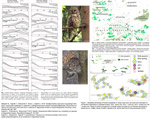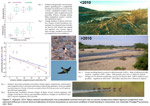Ecology and conservation biology of birds
Ecological research conducted at the Department concerns various groups and species of birds and insects, but they are linked by issues related to the impact of changes in the environment on the composition and ecology of communities, as well as on species distribution or interspecific interactions. The research carried out so far concerns the following issues:
- the impact of anthropogenic environmental disturbances (invasive plants, air pollution, roads) on the birds’ occurrence, abundance, adaptations and functioning of their immune system,
- the impact of invasive plants on pollinators in the mosaic of agricultural landscape;
- habitat requirements and distribution of Orthoptera and Coleoptera insects in xerothermic habitats;
- the impact of forests structure, arboreal microhabitats and management on breeding bird diversity and distribution of rare species (woodpeckers, grouses, owls, raptors) in the Carpathians,
- the phylogeography, population genetics and ecology of pied woodpeckers belonged to the genus Dendrocopos and goosanders (Mergus merganser);
- the influence of natural and anthropogenic alternations of river channels and floodplains on breeding bird assemblages and predacious beetles being ndicators of naturalness and biodiversity,
- the habitat and spatial segregation of carnivorous birds (owls, raptors, piscivores),
- the influence of orchard management on the biodiversity of breeding birds;
The results and conclusions from these studies have allowed for a better understanding of the ecological and ethological factors which determine the occurrence of certain birds and insects, especially stenotopic, rare, threatened, and indicator species (including a protected group of farmland birds and rare species from the Orthoptera order) as well as common but model birds (tits, blackbird). The effects of these studies have also been implemented in the practical planning of bird conservation and the monitoring of certain populations of species through the designation of protected areas and co-authorship of guidelines for monitoring and ecological research.
Research was funded by the:
National Science Centre; Sonatina 2-NZ grant no. 2018/28/C/NZ8/00283 “Impact of invasive Caucasian hogweeds on farmland birds and pollinators in heterogeneous landscape”; 2018-2021; PI – Emilia Grędzicka, Ph.D.; 2018-2021.
Ministry of Higher Education and Science; Iuventus Plus grant no 9007/IP1/2014/72; "Spatial and habitat segregation of the Ural and Tawny owls in fragmented forest landscape"; PI - Łukasz Kajtoch, Sc.D.; 2014-2016.
Research topic "Ecology, conservation biology and population genetics of birds" funded from statutory research of ISEA PAS; PI - Łukasz Kajtoch, Sc.D.; 2013-2020.
Research topic "Mechanisms of birds’ reaction to invasive plants" under the statutory funds of ISEA PAS; PI - Emilia Grzędzicka 2022-present
Research topic "Insect ecology in a diverse landscape" under the statutory funds of ISEA PAS; PI - Emilia Grzędzicka 2022-present
Publications:
Grzędzicka E., Hanzelka J., Reif J. 2022. The impact of invasive Caucasian hogweeds on birds depends on areas of invaded and uninvaded habitats at various scales in Central European uplands. Ecological Indicators 141, 109082: 1-17
Grzędzicka E. 2022. Impact of invasive weeds on the diversity and dissimilarity of bird communities in forested areas. Diversity 14 (3), 229: 1-23
Kajtoch Ł., Kusal B. 2022. The first case of a successful brood from a double hybrid mixed pair Dendrocopos syriacus x D. major (Picidae). Ibis 164: 1273–1277
Fedyń I., Grzędzicka E., Wiehle D., Kajtoch Ł. 2021. The co-occurrence of Ural Owl and Northern Goshawk differs between extensive and fragmented forests. Bird Study. 68: 267-278
Grzędzicka E., Reif J. 2021. The impact of Sosnowsky’s Hogweed on feeding guilds of birds. Journal of Ornithology 162: 1115-1128
Pons J.-M., Ventura C.D., Chiozzi G., Ettwein A., Grangé J.-L., Kajtoch Ł., Mazgajski T., Rakovic M., Winkler H., Fuchs J. 2021. Phylogeography of a widespread Palaearctic forest bird species: the White-backed Woodpecker (Aves, Picidae). Zoologica Scripta. 50: 155-172
Grzędzicka E., Vahed K. 2020. Habitat requirements of the endangered heath bush-cricket Gampsocleis glabra (Orthoptera, Tettigoniidae) in an isolated population. Journal of Insect Conservation 24: 935-945
Grzędzicka E. 2020. Impact of road distance and experimental challenge of the maternal immune system on the offspring immunocompetence. Ornis Fennica 97:00-00
Grzędzicka E., Reif J. 2020. Impacts of an invasive plant on bird communities differ along a habitat gradient. Global Ecology and Conservation 23: e01150
Grzędzicka E. 2019. Is the existing urban greenery enough to cope with current concentrations of PM2.5, PM10 and CO2? Atmospheric Pollution Research 10 (1): 219-233
Lešo P., Kropil R., Kajtoch Ł. 2019. Effects of forest management on bird assemblages in oak-dominated stands of the Western Carpathians - refuges for rare species. Forest Ecology and Management. 453: 117620
Matysek M., Kajtoch Ł., Gwiazda R., Binkiewicz B., Szewczyk G. 2019. Could gaps and diverse topography compensate for habitat deficiency by the forest-dwelling bird Hazel Grouse (Tetrastes bonasia)? Avian Biology Research. 12: 59–66
Gurgul A., Miksza-Cybulska A., Szmatoła T., Jasielczuk I., Semik-Gurgul E., Bugno-Poniewierska M., Figarski T., Kajtoch Ł. 2019. Evaluation of genotyping by sequencing for population genetics of sibling and hybridizing birds: an example using Syrian and Great Spotted Woodpeckers. Journal of Ornithology. 160: 287–29
Figarski T., Kajtoch Ł. 2018. Differences in habitat requirements between two sister Dendrocopos woodpeckers in urban environments: implication for the conservation of Syrian Woodpecker. Acta Ornithologica. 53: 23–36
Figarski T., Kajtoch Ł. 2018. Hybrids and mixed pairs of Syrian and great-spotted woodpeckers in urban populations. Journal of Ornithology. 159: 311-314
Kajtoch Ł., Lešo P., Matysek M., Kata M., Gacek S., Zontek C., Bisztyga A., Gwiazda R. 2017. Do flocks of great cormorants and goosanders avoid spatial overlap in foraging habitat during the non-breeding season? Aquatic Ecology.51: 473-483
Kajtoch Ł., Figarski T. 2017. Comparative distribution of Syrian and Great spotted woodpeckers in different landscapes of Poland. Folia Zoologica. 66: 29–36
Kajtoch Ł. 2017. The importance of traditional orchards for breeding birds: The preliminary study on Central European example. Acta Oecologica. 78: 53–60
Kajtoch Ł., Matysek M., Figarski T. 2016. Spatio-temporal patterns of owl territories in fragmented forests are affected by a top predator (Ural owl). Annales Zoologici Fennici 53: 165-174.
Kajtoch Ł., Wilk T., Bobrek R., Matysek M. 2016. The importance of forests along submontane stream valleys for bird conservation: The Carpathian example. Bird Conservation International. doi:10.1017/S0959270915000179.
Kajtoch Ł., Żmihorski M., Wieczorek P. 2015. Habitat displacement effect between two competing owl species in fragmented forests. Population Ecology.57: 517-527.
Figarski T., Kajtoch Ł. 2015. Alterations of riverine ecosystems adversely affect bird assemblages. Hydrobiologia 744: 287-296.
Michalczuk J., McDevitt A., Mazgajski T.D., Figarski T., Ilieva M., Bujoczek M., Malczyk P., Kajtoch Ł. 2014. Tests of multiple molecular markers for the identification of Great Spotted and Syrian Woodpeckers and their hybrids. Journal of Ornithology 3: 591-600.
Kajtoch Ł.. Żmihorski M., Piestrzyńska-Kajtoch A. 2014. The Goosander as potential indicator of naturalness and biodiversity in submontane river valleys of northern Carpathians. Ecological Indicators 45: 83-92.
Kajtoch Ł., Bobrek R. 2014. Extension of Goosander Mergus merganser distribution into the Carpathian Mountain range. Wildfowl 64:91-101.
Kajtoch Ł., Figarski T. 2013. Short-term revival of riverine bird assemblages after severe flood. Bird Study 60: 327-334.
Kajtoch Ł., Żmihorski M., Bonczar Z. 2012. Hazel Grouse occurrence in fragmented forests: habitat quantity and configuration is more important than quality. European Journal of Forest Research 131: 1783–1795.
McDevitt A.D., Kajtoch Ł., Mazgajski T.D., Carden F.R., Coscia I., Osthoff C., Coombes R.ZH., Wilson F. 2011. The origins of great spotted woodpeckers (Dendrocopos major) colonizing Ireland revealed by mitochondrial DNA. Bird Study 58: 361–364.
Bylicka M., Kajtoch Ł., Figarski T. 2010. Habitat and landscape characteristics affecting the Ural Owl Strix uralensis occurrence in agro-forestry mosaic. Acta Ornithologica 45: 33-42.



